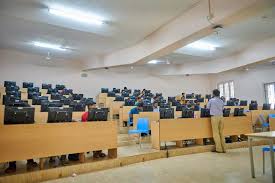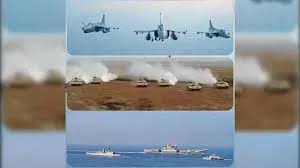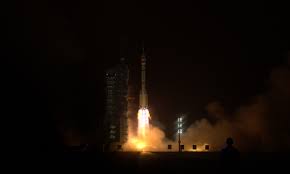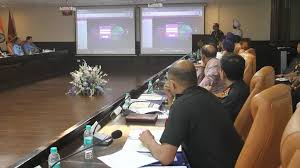Today’s Current Affairs: 18th November 2024 for UPSC IAS exams, State PSC exams, SSC CGL, State SSC, RRB, Railways, Banking Exam & IBPS, etc
Table of Contents
Scarlet Tanager:

The rare bird, Scarlet Tanager, was recently spotted in the UK for the first time in 40 years.
- Scarlet Tanager is a strikingly beautiful songbird native to North America.
- Scientific Name: Piranga olivacea
- Breeds in deciduous and mixed deciduous-evergreen forests; winters in forests and forest edges.
- They migrate to tropical forests in Central and South America during winter.
- They are medium-sized songbirds with fairly stocky proportions. They average seven inches in length.
- They have thick, rounded bills suitable both for catching insects and eating fruit.
- The head is fairly large, and the tail is somewhat short and broad.
- In spring and summer, adult males are unmistakable, brilliant red with black wings and tails.
- Females and fall immatures are olive-yellow with darker olive wings and tails.
- After breeding, adult males molt to female-like plumage, but with black wings and tails.
- The Scarlet Tanager’s song is often described as sounding like a “robin with a cold.” The bird’s call, an emphatic “chip-burr,” is also distinctive and often can be a giveaway to the bird’s location in a leafy treetop.
- IUCN Red List: Least Concern
Asia-Pacific Economic Cooperation:

US President Joe Biden and Chinese counterpart Xi Jinping recently warned of turbulent times ahead, in remarks at an Asia-Pacific economic summit in Lima overshadowed by Donald Trump’s impending return to the White House.
- Asia-Pacific Economic Cooperation (APEC) is a regional economic forum established in 1989 with the purpose of promoting free trade and investment and enhancing cooperation in social and development areas to advance prosperity, sustainable, and inclusive economic growth in the region.
- APEC ensures that goods, services, investments, and people move easily across borders.
- Members facilitate this trade through faster customs procedures at borders, more favorable business climates behind the border, and aligning regulations and standards across the region.
- APEC has contributed to the reduction of barriers to trade in the region over time, leading to the expansion of economic growth and international trade.
- Currently, APEC has 21 members. The 21 members are not necessarily 21 countries.
- Each member is considered an “economy” since APEC is primarily concerned with trade and economic dealings.
- The grouping’s current members are Australia, Brunei, Hong Kong, New Zealand, Papua New Guinea, the Philippines, Indonesia, China, Japan, South Korea, Russia, Canada, the United States, Mexico, Peru, Chile, Malaysia, Vietnam, Singapore, Thailand, and Taiwan.
- The 21 APEC member economies account for nearly 40 percent of the global population, almost half of the global trade, and approximately 60 percent of global GDP.
- APEC holds annually the APEC Economic Leaders Meeting, attended by the heads of government of all APEC members.
- Decisions made within APEC are reached by consensus, and commitments are undertaken on a voluntary basis.
- APEC’s activities are coordinated by the APEC Secretariat located in Singapore.
Partnerships For Accelerated Innovation And Research (PAIR) Initiative:

The Centre recently launched an initiative called Partnerships for Accelerated Innovation and Research (PAIR) to support research in universities, especially central and state public universities.
- Partnerships for Accelerated Innovation and Research (PAIR) Initiative is an initiative of the Anusandhan National Research Foundation (ANRF).
- It Stimulate scientific innovation in institutions with limited research in a mentorship mode by leveraging the knowledge and expertise of top-ranking institutions.
- It Support internationally competitive research with substantial impact and outcome.
- It Foster successful and productive collaborative networks between diverse institutions.
- Propel the advancement of institutions by (i) upscaling and building advanced research infrastructure and capabilities, (ii) enhancing the quality of research, and (iii) facilitating the infusion of best practices and research culture.
- While being aligned with the objectives set by the National Education Policy (NEP) 2020, the PAIR programme will cultivate research excellence in central and state public universities by fostering collaborations with top-tier institutions via a mentorship-driven hub and spoke model.
- The hubs will guide emerging institutions (spokes) in research activities, and provide access to harness their resources and expertise, thus bridging the gap between institutions and nurturing a robust research ecosystem in India.
- In the first phase, the Hub institutions would include the top 25 National Institutional Ranking Framework (NIRF) overall ranking as well as Institutions of National Importance within the top 50 NIRF overall ranking.
- The spoke institutions will include, Central and State Public Universities and select NITs and IIITs.
- Eligibility conditions would be expanded to include other universities and institutions in the subsequent phases.
- Each PAIR network would consist of one hub and up to seven spoke institutions.
- Only one proposal per hub institution is allowed, with a mandatory involvement of multi-departmental faculty teams from spoke institutions.
- Regional diversity among participants will also be ensured.
- The programme would help stimulate innovation in emerging institutions by leveraging mentorship from high-ranking institutions.
Exercise Poorvi Prahar:

The Indian Army is conducting a high-intensity tri-service exercise, ‘Poorvi Prahar’, in the forward areas of Arunachal Pradesh.
- Exercise Poorvi Prahar aims to hone the combat effectiveness of the Army, Navy, and Air Force in executing Integrated Joint Operations in the challenging mountainous terrain of the region, enhancing inter-service coordination and operational readiness.
- It brings together a wide spectrum of cutting-edge military platforms and systems, showcasing India’s advancements in modern warfare technology.
- A key feature of this exercise is the integration of innovative technologies that are reshaping the future of military operations.
- Troops are operating and refining skills with Swarm Drones, First Person View (FPV) Drones, Loitering Munitions, and cutting-edge technologies that dramatically enhance situational awareness, precision strikes and operational flexibility.
- The incorporation of these tools into the exercise reflects the military’s commitment to leveraging next-generation technologies to bolster defence capabilities.
- It serves as a platform for further absorption and integration of advanced technological tools and joint command structures that improve collaboration across services.
- One of the core components of the exercise is the development of a Common Operating Picture (COP) through joint control structures that optimise coordination between ground, air, and naval forces.
- Real-time information is seamlessly shared through systems operating on satellite communications, powered by AI-driven analytics, enabling more precise decision-making and faster response times.
- By conducting Ex Poorvi Prahar, the Indian Armed Forces are enhancing their ability to execute seamless, multi-domain operations across land, air, and sea, reinforcing India’s strategic deterrence capabilities.
CAG Report on Urban Local Bodies:

The Comptroller and Auditor General (CAG) of India highlighted critical gaps in the functioning of Urban Local Bodies (ULBs) across 18 states, 31 years after the 74th Constitutional Amendment was introduced to empower these self-governing institutions.
Data on Urban Local Bodies:
- ULBs face a 42% gap between their resources and expenditures.
- Only 32% of revenue comes from own resources; 68% is dependent on Union and state government transfers.
- ULBs realize only 56% of property tax demands.
- Only 29% of ULB expenditure is spent on programmatic and developmental work.
- Average vacancy rate: 37% of sanctioned strength.
- Urban bodies in 16 states have limited or no autonomy over recruitment.
- On average, 17 out of 18 functions (as per the 74th Amendment) are devolved.
- Nine states (e.g., Chhattisgarh, Maharashtra) devolved all 18 functions.
- Urban planning and fire services remain the least devolved functions.
Zebrafish : Part Of China Shenzhou-18 Mission

Chinese astronauts successfully reared four zebrafish in space which was part of the Shenzhou-18 mission.
- Zebrafish is a small (2-3 cm long) freshwater fish found in tropical and subtropical regions.
- The vertebrate takes its name from the horizontal blue stripes running the length of its body.
- It is native to South Asia’s Indo-Gangetic plains, where they are mostly found in the paddy fields and even in stagnant water and streams.
- It attracts developmental biologists due to its adequate regeneration capacity of almost all its organs, including the brain, heart, eye, and spinal cord.
- It possesses several advantages over rodent models in the study of vertebrate development and disease.
- These include hundreds of embryos in a single clutch and optical clarity of the developing embryo (have transparent larvae and embryos), which allows live imaging at the organism level.
- They are easily bred in large numbers with a relatively low maintenance cost.
- Approximately 70 percent of zebrafish genes are also present in a similar form in humans.
- Over 80 percent of genes that are known to trigger disease in humans are also present in this fish.
- Conservation status IUCN: Least concerned.
AI-enabled e-Tarang System:

The Ministry of Defence launched the AI-enabled e-Tarang System.
- It is a unique software, developed in collaboration with Bhaskaracharya National Institute for Space Applications and Geo-informatics (BISAG-N).
- It will improve planning for the interference-free operation of defence equipment during both wartime and peacetime.
- It will enable automated, efficient planning and management of Defence Spectrum, as well as support the development of newer technologies in higher frequency bands.
- It is set to support rapid decision-making, thereby allowing seamless integration of newer technologies critical for modern defence applications.
- BISAG-N is an Autonomous Scientific Society of the Ministry of Electronics & Information Technology (MeitY), Government of India.
- It undertakes technology development and management, research and development, facilitation of National and international cooperation, capacity building, and support of technology transfer and entrepreneurship development in geospatial technology.
- The Organisation has three main domain areas: Satellite Communication, Geo-informatics and Geo-spatial technology.
Khap Panchayat:

Khap Panchayats are sometimes seen in the news for multiple reasons, with some leaders advocating for progressive reforms to address key social and economic issues, including unemployment, education, and rural development.
- Efforts are also being made to modernise and regulate Khap Panchayats, integrating them into formal Alternative Dispute Resolution (ADR) systems for better governance and accountability.
- Khap Panchayats are traditional community-based councils primarily in North India, especially in Haryana and Uttar Pradesh, that function as informal judicial bodies.
- Originating centuries ago, they were formed among kinship groups (Khaps) to address social and governance issues within their communities.
- The system played a significant role in maintaining social order in rural societies, acting as a forum for conflict resolution within caste hierarchies, and operating parallel to formal legal systems while prioritising customary norms.
Black Hole Triple System:

A recent study has discovered the first black hole triple system, located 8,000 light-years away, differing from typical black holes , usually found as isolated entities or in binary systems.
- A light year is the distance light travels in a year, 5.9 trillion miles (9.5 trillion km).
- A black hole triple system consists of a central black hole and two orbiting stars, bound together by gravitational forces.
- It forms through a “direct collapse” process, where a massive star collapses inward without undergoing a supernova explosion, enabling nearby stars to remain gravitationally attached.
- The process of direct collapse, also termed a “failed supernova”, creates a gentler formation mechanism, avoiding the violent ejection of surrounding matter.
- This unique structure challenges traditional models of black hole formation and demonstrates the complex gravitational dynamics that can exist in stellar systems.
58th Meeting of National Mission for Clean Ganga:
The 58th Executive Committee meeting of the National Mission for Clean Ganga (NMCG) approved several pivotal projects aimed at Ganga River conservation, addressing environmental challenges.Environmental Flow Assessment was approved to assess the environmental flow of Chambal, Son, Damodar, and Tons rivers for enhancing water quality and biodiversity. Dolphin Rescue Initiative was approved to develop a Dolphin Ambulance and raise awareness for Ganga River dolphin conservation.
India’s Cooperative Movement:
India’s cooperative movement, rooted in the ethos of Vasudhaiva Kutumbakam (“the world is one family”), has played a transformative role in fostering inclusive growth, empowering marginalized communities, and driving rural development. Cooperative societies are voluntary organizations where individuals with shared interests collaborate to achieve common economic goals. They operate on principles of self-help, mutual assistance, and prioritizing community welfare over profit. Members pool resources, collectively use them, and derive shared benefits.
PPP plus PPP’ Model:
On World Diabetes Day, Union Minister for Science and Technology Jitendra Singh introduced the innovative ‘PPP plus PPP’ model, aimed at addressing India’s diabetes epidemic through collaborative efforts between domestic and international stakeholders. ‘PPP plus PPP’ model is adual-layered collaboration model combining Public-Private Partnerships (PPP) within India with international PPP collaborations. Objective: To enhance healthcare infrastructure, promote innovation, and make diabetes care accessible and affordable.
Operation Dronagiri:
The Operation Dronagiri, launched under the National Geospatial Policy 2022 by the Department of Science and Technology (DST), aims to integrate geospatial technologies into key sectors like agriculture, livelihoods, and logistics. Launched by: Department of Science and Technology (DST).Date: November 13, 2024. Objective: Demonstrate the applications of geospatial technologies to improve citizens’ quality of life and ease of doing business.
Sami, Forest Finns, and Kvens Tribes:
The Norwegian Parliament issued a formal apology to the Sami, Forest Finns, and Kvens for the historical injustices caused by its “Norwegianisation” policy. This forced assimilation, practiced from the 18th century until the 1980s, led to cultural erasure, loss of languages, and forced relocations.
External Affairs Minister Inaugurates Symbiosis Dubai Campus:
On the occasion of the inauguration of Symbiosis International University’s first international campus at Dubai Knowledge Park, External Affairs Minister Dr. S. Jaishankar and UAE Minister Sheikh Nahyan bin Mubarak Al Nahyan highlighted the significance of the event for both nations, particularly in terms of education and bilateral relations.
World Day of Remembrance for Road Traffic Victims:
The World Day of Remembrance for Road Traffic Victims (WDR) is observed on the third Sunday of November each year. It is a global event dedicated to honoring the millions of lives lost or severely affected by road traffic accidents. This day also highlights the suffering of victims, their families, and communities, while advocating for stronger action to prevent road crashes and their consequences.
Why Bharat Matters’ EAM Jaishankar’s New Book Launched in Dubai:
External Affairs Minister Dr. S. Jaishankar launched his new book, Why Bharat Matters, at the Mohammed Bin Rashid Library in Dubai, UAE. The event, held on 14th November, allowed Dr. Jaishankar to provide insights into the themes of his book, focusing on India’s evolving role in a shifting global landscape. The book touches upon global transformations, India’s internal progress, and the importance of self-reliance in assessing global challenges.




